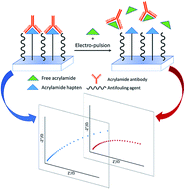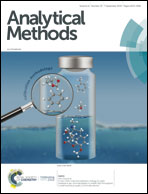A sample pre-treatment-free electrochemical immunosensor with negative electro-pulsion for the quantitative detection of acrylamide in coffee, cocoa and prune juice†
Abstract
Acrylamide is a potential carcinogen mainly found in heat-processed foods and its advised maximum intake is 2.6 μg kg−1 of body weight per day to prevent cancer risk; hence, a rapid detection method for acrylamide is strongly needed for food monitoring. In this study, a sample pre-treatment-free electrochemical immunosensor was developed via a displacement assay. The leaving of the anti-acrylamide antibody from the electrode surface is the predominant factor for an effective displacement assay. The dissociation rate of the antibody from the surface-bound hapten was enhanced by applying a negative electro-pulsion to the electrode surface. The pulsing duration and pulsing potential for the dissociation of the anti-acrylamide antibody were experimentally optimized. A three-level three-factorial Box–Behnken experimental design was employed in the present study to confirm the optimal displacement condition required based on a minimal experiment number (17 trials) without involving all possible experimental combinations. A linear dynamic range from 0.01 to 35.00 μg mL−1 was obtained, with the limit of detection (LOD) of 3.84 ng mL−1. The accuracy of the developed immunosensor was validated by using a standard method: gas chromatography-mass spectrometry (GC-MS). Moreover, the recoveries obtained from the spiked samples ranged between 90.33% and 99.23%. Hence, this method showed high selectivity and sensitivity for acrylamide determination in liquid food samples. Due to its simplicity of use, which excludes sample pre-treatment steps, this developed immunosensor has the potential to provide direct and quantitative acrylamide detection that is not significantly affected by food matrices.



 Please wait while we load your content...
Please wait while we load your content...